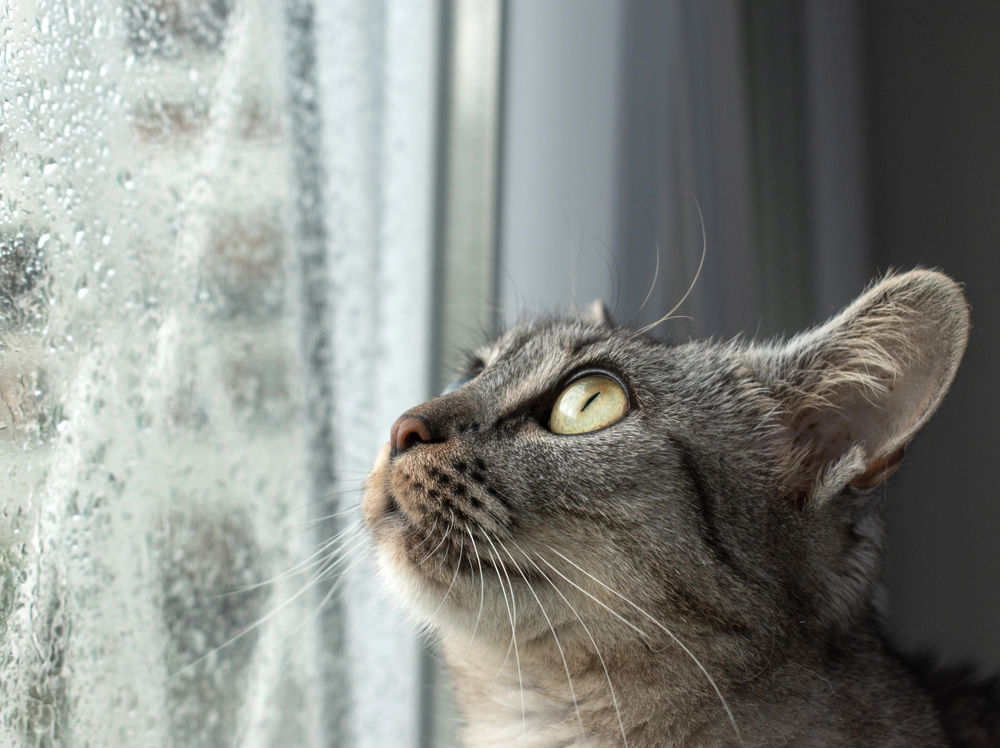
If your pet is scared of thunderstorms then, like millions of other owners in the UK, the sight of their worried eyes peeping out from under the bed may be an all too familiar sight. In this article we’ll delve into why your pet may be scared, as well as giving you some hints and tips on how you can help them feel safer when the banging and crashing of thunder begins.
Reasons why your pet is scared
It’s natural for an animal to be wary of loud noises, particularly if they don’t know what the noise is or where it’s coming from. Evolution has hard-wired our pets with incredible survival instincts and therefore loud unexpected noises can trigger a fight-or-flight response. Their reaction to loud noises is largely determined by their personality and past experiences. If they’ve been scared by thunder once, then, chances are, they will remember it and be scared again.
Noise aversion can also be influenced by species, breed, age and sex. Even the way your pet reacts to loud sounds could be partly controlled by their genetics. Research has shown that German Shepherd Dogs are more likely to pace when stressed, while Border Collies and Australian Cattle Dogs are more likely to hide.
Your pet's hearing
Many pets are renowned for having an incredible sense of smell, but their hearing can be remarkable too. Both dogs and cats can hear sounds that are around four times further away than we can and can also detect sounds at different frequencies to us. Their acute sense of hearing means that loud noises that are tolerable to us might be uncomfortable and unpleasant to them.
Unpredictability
The deafening sound of a clap of thunder can make us jump out of our skin and our hearts race, so to a pet with outstanding hearing, the noise must be unbearable. But a thunderstorm is not always just a sudden surprising loud sound, it’s often accompanied by heavy rain, strong winds and flashing lights. The noise of an approaching storm also builds tension and suspense, with many pets detecting low-frequency rumblings well before we can. The unpredictable nature of thunderstorms, the build in suspense and the volume and intensity of the storm could all make the experience terrifying for our pets, but this isn’t the whole story.
Changes in pressure
As a storm approaches, atmospheric pressure can change, and, rather incredibly, our pets may be able to detect this. The air that surrounds us has weight and pushes down on everything. This exertion of weight is known as atmospheric pressure. Changes in the atmosphere, such as air warming and expanding, or water vapour cooling and producing clouds, changes the pressure. Stormy weather causes a drop in the atmospheric pressure and this changes the way that odours travel around in the air. Your pet’s super sniffer may be sensitive enough to pick up on the differences in how smells are drifting and get an advanced warning of an oncoming storm. Knowing that a storm is approaching could cause noise phobic pets increasing stress and anxiety as they anticipate the impending thunderstorm.
Static build up
Thunderstorms not only cause a change in atmospheric pressure, but they can also charge the air with electricity too. Some believe that this change in the environment allows static to build up more easily in the coats of some pets, especially those that are larger or have a long or double coat. For pets that are already scared of storms, associated static shocks are not only going to be uncomfortable, but they could also increase their phobia too. Some have even noted that when dogs look for somewhere to hide during a storm, they sometimes look for places that are grounded against electric shocks, such as bathtubs or behind the toilet.
How to help your noise phobic pet
Thunderstorms can be fear-provoking, and although there may be different triggers that cause your pet to be scared, there’s a number of different ways you can support them.
If you know your pet dislikes thunderstorms, then you can help them acclimatise to these sounds well in advance by using a noise CD or downloading similar sounds.
Hints and tips for during or just before a thunderstorm:
- Shut all doors and windows and draw the curtains
- Make a safe den for your pet filled with their favourite blankets, toys, or some of your unwashed clothing to help them feel safe
- Ensure that their microchipping details are up-to-date in case they manage to run away
- For dogs, try giving them a thunder shirt (a special tight-fitting jacket that can help them feel safe)
- Drown out the noise with the TV or radio
- Play with them, give then lots of positive attention and reward calm behaviour with treats
